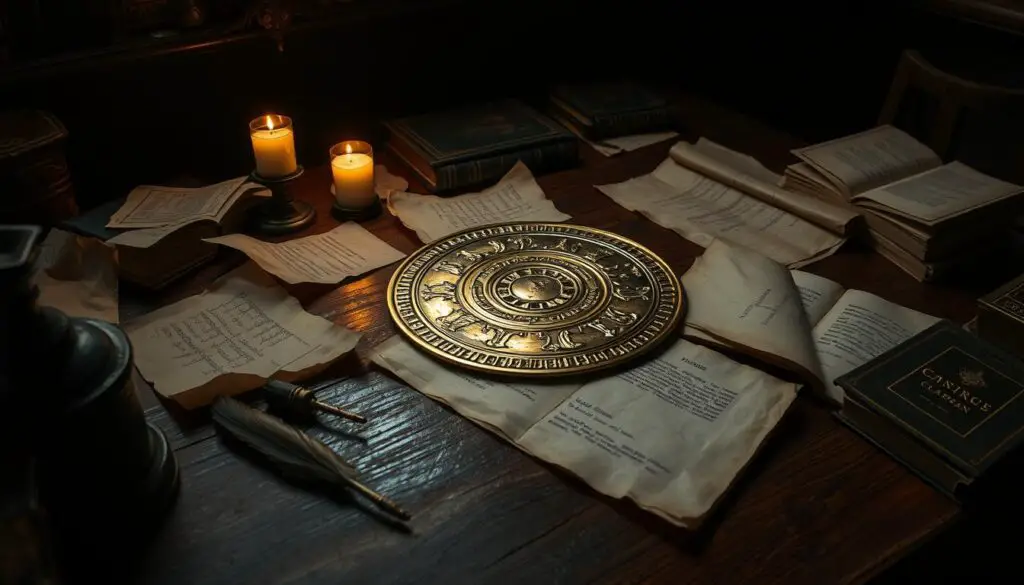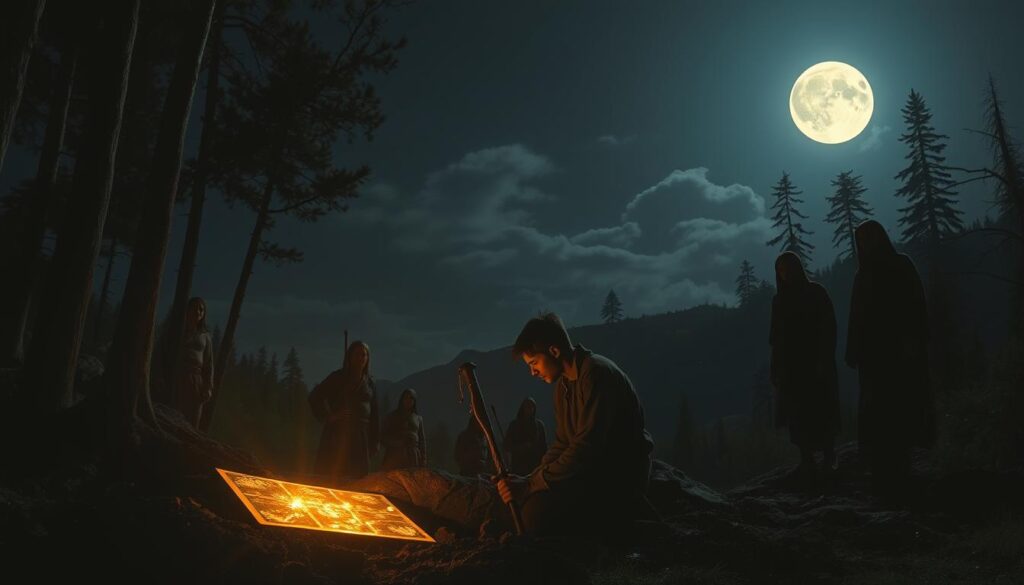At the heart of a foundational religious narrative lies a set of ancient artifacts known as the gold plates. These sacred objects, described as “gold in color” and etched with intricate symbols, are central to the origins of the Book of Mormon. According to tradition, a young man named Joseph Smith was guided by a divine messenger to uncover these records buried at Hill Cumorah in upstate New York.
The story begins in the early 19th century when Smith claimed an angel named Moroni revealed the plates’ location. Weighing approximately 60 pounds and bound with metal rings, their physical presence sparked both curiosity and skepticism. Smith later translated the inscriptions using a seer stone, a process that supporters view as miraculous.
This journey from discovery to translation spanned years, intertwining spiritual conviction with historical mystery. The plates’ connection to Jesus Christ’s teachings and their role in shaping a religious movement continue to inspire reverence. While the original artifacts remain unseen today, their legacy endures through written accounts and testimonies from witnesses.
Key Takeaways
- The gold plates are central to the origins of the Book of Mormon and its religious teachings.
- Joseph Smith reported discovering the plates with guidance from the angel Moroni.
- Descriptions highlight their metallic appearance and ancient engravings.
- Translation involved unique methods, including the use of a seer stone.
- Multiple witnesses attested to the plates’ existence, adding historical context.
- The narrative blends spiritual significance with 19th-century American history.
Introduction to the Golden Plates and Their Significance
Central to the faith of many is a collection of metal records said to contain ancient teachings. These artifacts, often called the golden plates, became the foundation of the Book of Mormon. According to accounts, Joseph Smith unearthed them in 1827 after years of preparation guided by a heavenly messenger.
The plates’ story blends spiritual purpose with historical intrigue. Joseph Smith described them as a “sacred record” written by prophets centuries ago. Their translation, he claimed, required divine tools like a seer stone and guidance from the angel Moroni. This process transformed symbols into scripture, creating a text millions revere today.
For members of the Church of Jesus Christ, these records are more than relics. They symbolize a direct connection to God’s teachings and the ministry of Jesus Christ. Eyewitness testimonies from those who saw the plates add layers to their cultural importance. Though unseen now, their influence remains woven into worship practices and community identity.
This narrative sets the stage for exploring how ancient records shaped a modern faith. Next, we’ll delve into their origins and the events that brought them to light.
Origins and Early Accounts of the Plates
The story of these sacred artifacts begins in a swirl of frontier folklore and spiritual hunger. Upstate New York’s “burned-over district” earned its name from intense religious revivals that swept through the region. This environment shaped how people interpreted unusual claims—including tales of buried treasures and divine messages.

Discovery Stories and Folk Traditions
Long before the Book of Mormon emerged, Joseph Smith’s family participated in treasure-digging ventures common in early America. Folk magic practices, like using seer stones to locate hidden items, were part of local culture. Stories circulated about ancient metal records buried by Indigenous peoples—a theme that later intertwined with Smith’s spiritual mission.
A Landscape of Spiritual Ferment
The 1820s saw New York buzzing with new religious movements. Revivalist preachers drew crowds, while rumors of mystical findings spread quickly. When Smith described encounters with an angel guiding him to a golden record, some neighbors saw it as another curious chapter in the area’s spiritual saga. Others viewed it skeptically, recalling failed treasure hunts.
Early accounts from Smith’s associates blended wonder with practical details. One witness noted the artifacts felt “heavier than wood”, suggesting their metallic nature. These narratives—part myth, part history—laid groundwork for a text that would shape a global faith community.
Joseph Smith’s Vision and Encounter with Angel Moroni
In 1823, a young man’s prayer ignited a series of events that would reshape religious history. Joseph Smith, then 17, described a luminous figure appearing in his bedroom—an angel named Moroni. This celestial messenger declared a divine mission involving ancient records buried nearby.
Divine Commandments and Instructions
Moroni’s message carried strict guidelines. Smith was told the gold plates contained sacred teachings of Jesus Christ and could only be retrieved after four years of preparation. The angel warned against showing the artifacts to skeptics, emphasizing their spiritual purpose over curiosity.
Central to the instructions was obedience. Smith learned he’d need special tools—the Urim and Thummim—to translate the engravings. These stone interpreters, mentioned in the Book of Mormon, became key to unlocking the ancient record’s message.
The Angel’s Role in the Revelation
Angel Moroni appeared multiple times, reinforcing Smith’s resolve. Each visit clarified the plates’ significance as a “work of God” rather than worldly treasure. The heavenly guide framed the mission as both a personal test and a restoration of divine truth.
This visionary experience laid the foundation for translating what later became the Book of Mormon. Through these encounters, Smith’s role shifted from farmhand to prophet in the Church of Jesus Christ. The angel’s repeated visits created a bridge between ancient teachings and 19th-century America.
Journey to Retrieve the Plates
Retrieving the sacred artifacts was no simple task. Joseph Smith faced years of setbacks before securing the ancient record. Guided by the angel Moroni, he made annual visits to the burial site starting in 1823. Each attempt ended in failure, often met with divine warnings about his readiness.

Trials and Divine Intervention
Smith’s fourth year brought new challenges. Stories claim supernatural forces guarded the artifacts—storms erupted, and unseen hands pushed him back. Locals who heard rumors tried ambushing him, forcing secrecy. His family hid the metal records in clever spots, like hollowed-out logs, to avoid theft.
When success finally came in 1827, it unfolded dramatically. Smith raced through the night after retrieving the items, dodging rivals drawn by gossip. The angel’s strict rules shaped every step: “The work must advance through faith, not force.”
This grueling process tested Smith’s resolve. Through physical struggles and spiritual lessons, the journey became a cornerstone for the Book of Mormon. It showed how perseverance and obedience turned a buried treasure into a sacred text.
The Role of Seer Stones in Translation
In early 19th-century America, certain objects bridged the gap between earthly pursuits and spiritual revelations. Among these were seer stones—smooth, polished rocks believed to reveal hidden truths. Initially tied to treasure hunting, these tools took on new meaning when Joseph Smith repurposed one to translate ancient writings.
From Treasure Hunting to Divine Guidance
Seer stones were common in folk magic circles. Hunters used them to locate lost items or buried valuables, often placing the stone in a hat to block light. Smith himself had searched for treasure this way before his religious mission began. But when tasked with translating the gold plates, he adapted the practice for sacred work.
Witnesses described Smith placing his stone into a hat, pressing his face against it, and reading aloud glowing words only he could see. This method transformed symbols into the Book of Mormon’s text over months of work. Critics called it superstition, while followers saw divine intervention.
The stone became part of the Urim and Thummim—tools mentioned in scripture for receiving revelation. This shift reframed a folk tradition as a channel for God’s message. It also sparked debates about faith versus fraud that still echo today.
Key aspects of this transition include:
- A tool of curiosity becoming a vessel for sacred translation
- The blending of frontier culture with spiritual innovation
- How early practices shaped the identity of the Church of Jesus Christ
This story mirrors broader themes in American religious history, where everyday objects often gained mystical significance. The seer stone’s journey—from dirt to divinity—remains a testament to how faith can redefine tradition.
Description and Physical Characteristics of the Golden Plates
Crafted with precision that defied 19th-century metallurgy, these artifacts resembled “gold in color” but carried unique properties. Witnesses described them as sheets of thin metal bound by three D-shaped rings, forming a volume roughly 6 inches wide and 8 inches tall.
Material, Design, and Engravings
Though often called gold plates, their composition puzzled observers. Unlike common tin or copper, the metal leaves had an unusual density—weighing 40 to 60 pounds despite their compact size. Joseph Smith noted their surfaces were covered in “reformed Egyptian” characters, a script unknown to scholars of his time.
Three key features set them apart:
- Textured engravings that felt raised under fingertips
- Sealed portions requiring divine permission to open
- A binding system allowing easy page-turning
Eyewitnesses marveled at their craftsmanship. One observer recalled, “No human could’ve made these without special tools.” This reinforced beliefs in their sacred origin within the Church of Jesus Christ.
Their design—durable yet delicate—suggested both practical use and symbolic meaning. Unlike ordinary metal objects, they blended spiritual purpose with physical resilience, leaving a lasting impression on those who handled them.
Joseph Smith’s Translation Process
Translating ancient scripture required tools beyond ordinary means. Joseph Smith described using a sacred instrument called the Urim and Thummim—two stones set in silver bows—to decode the engraved characters. This device, mentioned in the Book of Mormon itself, became central to turning symbols into scripture.

The Use of the Urim and Thummim
Eyewitnesses reported Smith placing the stones in a hat to block ambient light. Glowing words would appear, which he dictated aloud to scribes. “It was not intended to tell the world all the particulars,” one associate noted, emphasizing the process’s spiritual nature over technical details.
The Urim and Thummim functioned as both translator and authenticator. Smith couldn’t proceed unless he focused completely, and errors vanished when he lost concentration. This method let him work rapidly—up to 10 pages daily—despite not directly reading the reformed Egyptian text.
Key aspects of this approach include:
- Divine tools enabling access to hidden knowledge
- A collaborative effort with scribes recording each word
- No physical contact with the artifacts during most sessions
Critics questioned the process, but supporters saw it as proof of heavenly aid. Today, this blend of revelation and practical work remains a defining—and debated—chapter in the Church of Jesus Christ’s origins.
Historic and Cultural Context of the Plates
Early 19th-century America buzzed with spiritual exploration and social change. Western New York’s “burned-over district” became a hotspot for religious revivals during the Second Great Awakening. Preachers like Charles Finney drew crowds seeking salvation, while rumors of buried treasures and divine messages spread like wildfire.

Religious Revivals and the Burned-Over District
This region earned its fiery nickname from intense spiritual fervor that left few untouched. Joseph Smith grew up in this environment, where camp meetings and visions coexisted with folk magic practices. As one revivalist declared, “The heavens seemed near enough to touch!”
Treasure hunting wasn’t just a hobby—it reflected a deeper hunger for connection to the past. Many believed ancient Indigenous civilizations had left sacred artifacts underground. When Smith described finding metal records through angelic guidance, some neighbors saw it as part of this cultural tapestry.
Three factors shaped public reception of the gold record narrative:
- Widespread belief in supernatural communication
- Economic instability driving treasure-seeking ventures
- Competing Christian groups seeking unique revelations
The Book of Mormon’s language mirrored biblical styles familiar to revival audiences. Eyewitness testimonies—carefully recorded and circulated—gave weight to claims that might’ve seemed outlandish elsewhere. This blend of faith and folklore created fertile ground for a new religious movement to take root.
Treasure Hunting and Occult Influences in Early Mormon History
The 1820s American frontier buzzed with more than just religious revivals—it thrived on hidden treasures and mystical quests. Joseph Smith grew up in this world, where digging for buried riches using seer stones was as common as Sunday sermons. His early reputation as a “seer” stemmed from successful treasure hunts, blending folk magic with frontier entrepreneurship.
Cultural beliefs about enchanted artifacts shaped how people interpreted Smith’s claims. Many neighbors saw his angelic visions as extensions of existing occult practices. One associate recalled, “We thought he’d find silver, not scripture.” This environment made the transition from treasure hunter to prophet both controversial and compelling.
Three key shifts occurred as Smith’s mission evolved:
| Treasure Hunting Practices | Religious Symbolism | Outcome |
|---|---|---|
| Using stones to locate metals | Seer stones became Urim and Thummim | Tools reframed as divine |
| Financial motivations | Focus on spiritual records | Shift to sacred purpose |
| Local folklore | Connection to Jesus Christ | Global religious movement |
Witnesses initially drawn by gold soon found themselves testifying about sacred texts. Smith’s ability to merge occult methods with biblical language helped build trust among early followers. What began as treasure maps became roadmaps for faith in the Church of Jesus Christ.
This transformation shows how cultural practices can shape spiritual revolutions. The same stones that once sought coins later channeled words that millions now cherish as scripture.
The mormon plates and Book of Mormon Witnesses
Eleven individuals stepped forward to validate the existence of sacred records that shaped a religious movement. Their testimonies—printed in every copy of the Book of Mormon—remain central to discussions about faith and historical evidence.
Eyewitness Testimonies and Recorded Experiences
Three men—Oliver Cowdery, David Whitmer, and Martin Harris—described a shared vision of an angel presenting the artifacts. Eight others testified they physically handled the “golden leaves”, noting their weight and engraved text. One witness wrote, “We saw with our eyes and handled with our hands.”
These accounts were documented in 1830 and later canonized by the Church of Jesus Christ. Supporters emphasize their consistency over time, while critics highlight that some signers later left the faith.
Controversies and Alternate Interpretations
Skeptics argue the witnesses’ spiritual experiences reflect 19th-century religious enthusiasm rather than physical proof. Some suggest financial ties to Joseph Smith influenced their statements. Others note discrepancies in later retellings.
Believers counter that none recanted their testimonies publicly. As one historian observed, “Faith and doubt often coexist in the same historical record.”
| Believers’ Perspective | Critics’ Response |
|---|---|
| Consistent testimonies across decades | Lack of physical evidence today |
| Shared spiritual conviction | Cultural pressure to conform |
| Canonized as scripture | Questions about translation methods |
These accounts continue shaping discussions about the Book of Mormon’s origins. For many, they represent a bridge between tangible history and personal conviction.
Scholarly Analysis and Historical Authenticity
The authenticity of ancient religious texts often sparks intense academic debate. Historians like Richard Bushman note the Book of Mormon presents a unique challenge—its claims rest on artifacts unseen by modern researchers. “Faith and history don’t always align neatly,” Bushman observes, highlighting tensions between spiritual conviction and empirical analysis.
Researchers use linguistic studies and archaeological comparisons to evaluate the text. Some point to reformed Egyptian characters as a potential anachronism, while others argue ancient Near Eastern parallels support its plausibility. Critics often cite missing physical evidence, though supporters emphasize eyewitness accounts from the 1820s.
Key debates focus on cultural details in the record, like references to horses or steel in pre-Columbian America. These elements clash with mainstream archaeology, creating what scholars call the “anachronism problem.” Yet, some researchers propose alternative interpretations, suggesting terms might symbolize unfamiliar concepts.
Believers view the text as a divine revelation tied to Jesus Christ’s teachings. Critics, however, see it as a product of its time—a blend of frontier folklore and biblical influences. This divide shapes how historians approach early Church of Jesus Christ history, balancing spiritual narratives with cultural context.
While no consensus exists, these discussions deepen understanding of 19th-century religious innovation. As Bushman notes, “The plates’ legacy lies not in their materiality, but in their power to inspire.” Whether seen as history or allegory, their impact on millions remains undeniable.
Comparative Study: Ancient Records and the Golden Plates
Ancient civilizations often preserved their histories through meticulously crafted records. The Book of Mormon describes multiple sets of metal documents, each serving distinct roles in transmitting spiritual and cultural knowledge. Understanding their differences reveals how ancient societies safeguarded their legacies.
Brass Plates Versus the Golden Plates
The brass plates predated the golden records, containing Hebrew scriptures and genealogies. Carried from Jerusalem to the Americas, they provided religious continuity for ancient peoples. In contrast, the golden artifacts compiled abridged histories over centuries. “One was a library, the other a distilled testimony,” noted one scholar.
| Feature | Brass Plates | Golden Plates |
|---|---|---|
| Origin | Jerusalem (600 BCE) | Ancient Americas |
| Content | Law of Moses, prophecies | Abridged history, Christ’s ministry |
| Purpose | Preserve Jewish traditions | Unite scattered narratives |
Small Plates and Large Plates: A Dual Record
Nephi, an ancient prophet, created two parallel records. The large plates focused on political events, while the small plates emphasized spiritual teachings. This dual system ensured both history and doctrine survived. As stated in the text: “A wise purpose known unto God” guided their separation.
| Aspect | Large Plates | Small Plates |
|---|---|---|
| Scope | Kings, wars, governance | Revelations, sermons |
| Time Covered | 1000+ years | 400-year portion |
| Compiler | Secular leaders | Prophetic lineage |
Mormon, a later historian, merged these records into a single volume. His edits highlighted patterns of faith across generations. This layered approach created a rich tapestry of people’s triumphs and struggles—a masterclass in preserving collective memory.
Legacy and Influence on Mormon Faith and Identity
The sacred narrative surrounding these ancient records has become a cornerstone of spiritual identity for millions. Their discovery and translation shaped foundational beliefs of the Church of Jesus Christ, anchoring its teachings in divine revelation. Over years, this story evolved from historical event to enduring symbol of faith.
Modern Latter-day Saints view the records as proof of God’s ongoing guidance. Teachings from the translated words appear in sermons, hymns, and temple ceremonies. One member shared, “They remind us that heaven speaks to earth even today.”
Key aspects of their cultural impact include:
- Scriptural references to Jesus Christ’s ministry in ancient America
- Missionary efforts sharing the story globally
- Artistic depictions in meetinghouses worldwide
| Historical Role | Symbolic Meaning |
|---|---|
| Source text for the Book of Mormon | Divine communication model |
| Witness testimonies | Community unity through shared belief |
| 19th-century translation process | Trust in spiritual gifts |
Debates about their physical existence continue, yet believers emphasize their spiritual fruits. As one leader noted, “The record’s power lies not in metal pages but changed hearts.” This legacy binds past and present, making the story inseparable from Latter-day Saints’ self-understanding.
Through generations, the narrative has fostered resilience during trials. Families share it as part of their heritage, ensuring its place in the faith’s future. Whether as history or metaphor, it remains a touchstone for millions seeking connection to Jesus Christ.
Impact on Modern Latter-Day Saints and Contemporary Beliefs
For millions today, ancient narratives shape modern devotion. The story of sacred records continues to guide spiritual practices in the Church of Jesus Christ. Weekly lessons often reference the plates’ translation as evidence of divine communication. Members see this legacy as a reminder that “God speaks to His children in every age,” fostering trust in ongoing revelation.
Historical accounts influence how believers approach challenges. Many find strength in parallels between early struggles and personal trials. One member shared, “Knowing prophets faced doubts helps me hold onto faith during hard times.” This connection bridges centuries, making ancient events feel relevant to modern lives.
Cultural traditions keep the narrative alive. Annual pageants reenact the plates’ discovery, while art in temples depicts key moments. Missionaries use the story to explain their faith’s origins, emphasizing its role in Christ’s teachings. These practices reinforce community identity across generations.
Facing historical questions, members often focus on spiritual outcomes over physical proof. As one leader noted, “The record’s power lies in changed hearts, not museum displays.” This perspective helps reconcile scholarly debates with personal conviction, allowing space for both inquiry and belief.
Ultimately, the plates symbolize unwavering trust in heavenly guidance. They remind Latter-day Saints that faith often requires stepping into the unknown—just as it did nearly 200 years ago. Their legacy remains not in metal pages, but in lives shaped by their message.
Conclusion
The journey of the sacred records from ancient artifact to spiritual cornerstone remains one of history’s most intriguing puzzles. Over a single year, their discovery and translation sparked a movement that reshaped religious faith for millions. Eyewitness accounts, linguistic debates, and unanswered questions continue to fuel discussions about their origins.
Central to this legacy is the interplay between language and belief. The translated words transformed obscure symbols into scripture, bridging past and present. For believers, this process affirms divine guidance. For scholars, it raises questions about cultural influences shaping the writing.
Today, the records’ absence from physical possession deepens their mystery. Yet their impact endures through communities built on shared conviction. As people worldwide engage with this story, they confront timeless tensions—between tradition and inquiry, evidence and devotion.
Whether viewed as historical artifact or allegory, these pages challenge us to explore how faith interprets the unseen. Their legacy invites curiosity, urging readers to weigh spiritual truths against earthly uncertainties. The search for understanding, much like the plates themselves, remains an unfolding journey.
FAQ
What are the Golden Plates, and why are they important?
The Golden Plates are an ancient record said to contain religious teachings and history. According to Latter-day Saint belief, they were translated by Joseph Smith into the Book of Mormon, forming a foundational scripture of the faith. Their significance lies in their role as a divine record of God’s interactions with ancient peoples in the Americas.
How did Joseph Smith find the Golden Plates?
Joseph Smith described being guided by an angel named Moroni to a hillside near Palmyra, New York, where the plates were buried. After four years of spiritual preparation, he retrieved them in 1827. Accounts mention challenges, including efforts to protect them from theft or misuse.
Were seer stones used to translate the plates?
Yes. Historical records suggest Joseph Smith used tools like the Urim and Thummim (described as “interpreters”) and a seer stone to aid in translating the text. These methods were seen as part of divine guidance, though details vary in early accounts.
What did the Golden Plates look like?
Witnesses described them as thin metal pages bound by rings, engraved with symbols in a language called reformed Egyptian. They were said to weigh about 40–60 pounds and measure roughly 6×8 inches. Some accounts mention a mixture of gold and other metals like tin.
Did anyone else see the Golden Plates?
Eleven men signed testimonies affirming they saw or handled the plates. These witnesses included close associates of Joseph Smith, and their accounts remain central to discussions about the plates’ authenticity. Critics, however, debate the nature of their experiences.
How does the Book of Mormon relate to ancient records?
The text mentions other records, such as the Brass Plates (brought from Jerusalem) and a division into “small plates” and “large plates” for different purposes. This dual structure reflects themes of preservation and spiritual teachings across generations.
What role did treasure hunting play in early accounts?
Joseph Smith’s family and community were familiar with 19th-century folk practices, including seeking buried items. Some scholars link this cultural context to early descriptions of the plates’ discovery, though believers emphasize their sacred purpose over secular treasure motives.
How have the plates influenced modern Latter-day Saints?
The story of the Golden Plates strengthens faith in Joseph Smith’s divine calling and the Book of Mormon’s teachings. For members of The Church of Jesus Christ of Latter-day Saints, they symbolize a tangible connection to God’s revelations and ancient prophets.